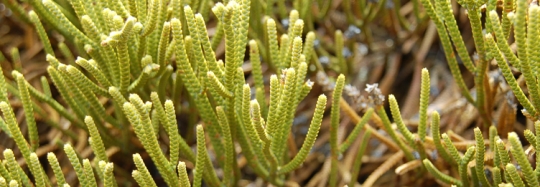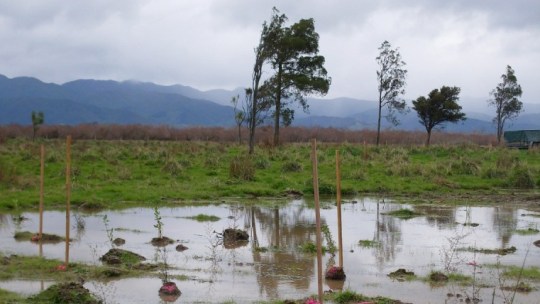Current Research
Plant rarity

Rarity in plant populations has two extremes. Some rare plants exist only in a small area and are quite clustered. In other cases, rare plants are found over a wide geographical area in a very low density.
Distribution patterns are influenced by
- climatic factors – the plant is rare because it has specific climatic requirements
- seed dispersal limitations – how far seeds can travel from the parent plant
- reproduction or population limitations – plants tend to cluster if pollination is required for fertilisation
The rarity of a species is an indicator of its extinction risk. Geographically restricted species are especially vulnerable to extinction by climatic factors, especially environmental catastrophes. Work in this area is also motivated by concerns regarding climate change and its impact on rare plant species.
A study of New Zealand Hebes (recently placed in the genus Veronica) is focussing on plant distribution patterns in Molesworth Station in the South Island of New Zealand. The plant community is recorded at multiple scales from plots 100x60m down to 1x1m quadrats. Within the study plots, Hebes are individually mapped with accurate GPS technology and the different distribution patterns then related back to the life history of the plants as the reasons for the different types of distribution are sought.
Bioclimatic modelling of invasive species
We study invasive insects, reptiles and plants.
We use bioclimatic models to predict where invasive species may become established in the New Zealand environment or across the globe. This computer modelling maps areas from the species’ home environment to the areas in New Zealand that could provide similar climatic conditions. An important feature of the technique is the ability to state the limits of the model and to express the certainty or uncertainty of the results in a manner that can be incorporated into a risk analysis exercise.
The modelling is performed in the program ‘R’, and code is made freely available with each publication.
Ants
Argentine ants were first reported in New Zealand in 1990. Although they are found mainly in the north of North Island, populations are now established in Wellington and Christchurch.
Our group has been monitoring new ant populations at Piha and Bayly’s Beaches, in the north of the North Island, to observe population spread and effects on native invertebrates and plants.
Turtles
Unwanted pets are regularly released into the environment. Adults can survive over winter, but so far there is no evidence of successful breeding in feral populations. Warmer climates will increase nest temperatures and may permit populations to establish and expand.
The turtles prey upon waterfowl chicks and compete with native wetland biodiversity.
Restoration ecology of sand dunes
Coastal sand dunes are a distinctive feature of the New Zealand landscape, but they are becoming increasingly rare due to human-induced alternations, habitat loss and introduction of non-indigenous species. As most sand dune ecosystems are located outside the existing conservation network and since anthropogenic pressure is likely to continue, it is not surprising they are one of the most threatened ecosystems in New Zealand.

Surveys of the condition and species composition of sand dunes are necessary if conservation and restoration initiatives are to be placed on a firm, evidence-based foundation. Moreover, comparisons between sites and between times are much more meaningful when the surveys follow a consistent monitoring protocol. To date, very few sand dune systems have been sampled and described in detail and there are no national standards on how to conduct such surveys.
We are investigating methods for “site integrity monitoring”, concerned not only with species of conservation status but also with the dune structure and vegetation community as a whole. This work has received funding from the Department of Conservation and Greater Wellington Regional Council. Other projects are testing the most effective way to replace exotic plant species such as Marram grass and south African ice-plant with native Spinifex and Pingao without passing through a stage of bare sand that represents a lack of habitat for sand dune fauna and is susceptible to erosion.
Wetland restoration
Wairio wetlands on the eastern shores of Lake Wairarapa are being restored by the charity Ducks Unlimited, working in collaboration with the Department of Conservation and Greater Wellington Regional Council. Their vision is to return a series of rough grazing paddocks into a thriving wetland with a full range of wetland plants and animals. We are involved in two research projects at the wetland restoration site (1) to investigate the seasonal dynamics of wetland turf species on the margins of ephemeral open water and (2) a large-scale experimental planting of over 2,300 trees to investigate the most cost-effective way to establish native wetland trees, such as kahikatea, in a seasonally-flooded meadow. A major concern is how to prevent tall fescue grass from out-competing the planted trees.
Further details via the Radio New Zealand podcast.
Forest ecosystem dynamics
Forest ecosystems in New Zealand are in a constant state of flux, responding to "bottom-up" bursts of productivity (as in years of mast seeding) and "top-down" predation from introduced mammal species. The trophic cascades (or ecosystem dynamics) that result from interacting "bottom-up" and "top-down" influences are not always easy to predict, just like when two waves meet from different directions – sometimes they reinforce each other and other times they cancel each other out. The aim of conservation management is to increase the abundance of native species, typically achieved by reducing the top-down influence of introduced predators. In Aorangi Forest and the Rimutaka Ranges we are monitoring populations of rodents, possums, insects and birds in response to these two forces in diverse beech-podocarp-broadleaf forests. Of particular interest is the role of invertebrates in this complex network of interacting populations. We work in collaboration with the Aorangi Restoration Trust, Department of Conservation and TbFree New Zealand.
Hear about our beetle and weta monitoring via Radio New Zealand podcast.
Foraging by insect herbivores
Are plants growing close together more vulnerable to attack by insects than widely spaced plants?
Work in this area is studying the herbivorous damage of cabbage white butterfly caterpillars on cabbage plants. We have obtained some interesting results, which suggest that single plants generally receive a disproportionate number of eggs, not because the isolated plant is inherently more attractive, but because insects passing by have no other option.
